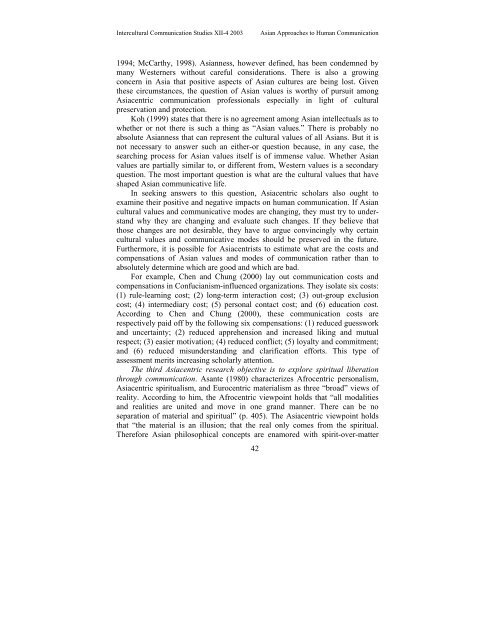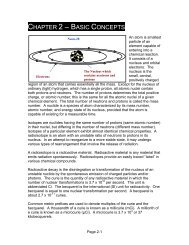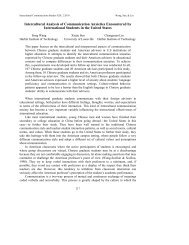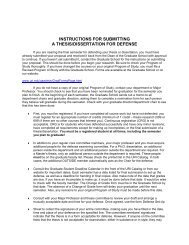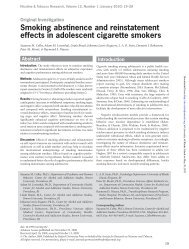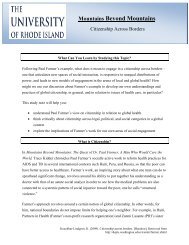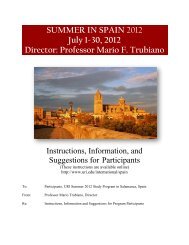asian approaches to human communication - University of Rhode ...
asian approaches to human communication - University of Rhode ...
asian approaches to human communication - University of Rhode ...
You also want an ePaper? Increase the reach of your titles
YUMPU automatically turns print PDFs into web optimized ePapers that Google loves.
Intercultural Communication Studies XII-4 2003 Asian Approaches <strong>to</strong> Human Communication<br />
1994; McCarthy, 1998). Asianness, however defined, has been condemned by<br />
many Westerners without careful considerations. There is also a growing<br />
concern in Asia that positive aspects <strong>of</strong> Asian cultures are being lost. Given<br />
these circumstances, the question <strong>of</strong> Asian values is worthy <strong>of</strong> pursuit among<br />
Asiacentric <strong>communication</strong> pr<strong>of</strong>essionals especially in light <strong>of</strong> cultural<br />
preservation and protection.<br />
Koh (1999) states that there is no agreement among Asian intellectuals as <strong>to</strong><br />
whether or not there is such a thing as “Asian values.” There is probably no<br />
absolute Asianness that can represent the cultural values <strong>of</strong> all Asians. But it is<br />
not necessary <strong>to</strong> answer such an either-or question because, in any case, the<br />
searching process for Asian values itself is <strong>of</strong> immense value. Whether Asian<br />
values are partially similar <strong>to</strong>, or different from, Western values is a secondary<br />
question. The most important question is what are the cultural values that have<br />
shaped Asian communicative life.<br />
In seeking answers <strong>to</strong> this question, Asiacentric scholars also ought <strong>to</strong><br />
examine their positive and negative impacts on <strong>human</strong> <strong>communication</strong>. If Asian<br />
cultural values and communicative modes are changing, they must try <strong>to</strong> understand<br />
why they are changing and evaluate such changes. If they believe that<br />
those changes are not desirable, they have <strong>to</strong> argue convincingly why certain<br />
cultural values and communicative modes should be preserved in the future.<br />
Furthermore, it is possible for Asiacentrists <strong>to</strong> estimate what are the costs and<br />
compensations <strong>of</strong> Asian values and modes <strong>of</strong> <strong>communication</strong> rather than <strong>to</strong><br />
absolutely determine which are good and which are bad.<br />
For example, Chen and Chung (2000) lay out <strong>communication</strong> costs and<br />
compensations in Confucianism-influenced organizations. They isolate six costs:<br />
(1) rule-learning cost; (2) long-term interaction cost; (3) out-group exclusion<br />
cost; (4) intermediary cost; (5) personal contact cost; and (6) education cost.<br />
According <strong>to</strong> Chen and Chung (2000), these <strong>communication</strong> costs are<br />
respectively paid <strong>of</strong>f by the following six compensations: (1) reduced guesswork<br />
and uncertainty; (2) reduced apprehension and increased liking and mutual<br />
respect; (3) easier motivation; (4) reduced conflict; (5) loyalty and commitment;<br />
and (6) reduced misunderstanding and clarification efforts. This type <strong>of</strong><br />
assessment merits increasing scholarly attention.<br />
The third Asiacentric research objective is <strong>to</strong> explore spiritual liberation<br />
through <strong>communication</strong>. Asante (1980) characterizes Afrocentric personalism,<br />
Asiacentric spiritualism, and Eurocentric materialism as three “broad” views <strong>of</strong><br />
reality. According <strong>to</strong> him, the Afrocentric viewpoint holds that “all modalities<br />
and realities are united and move in one grand manner. There can be no<br />
separation <strong>of</strong> material and spiritual” (p. 405). The Asiacentric viewpoint holds<br />
that “the material is an illusion; that the real only comes from the spiritual.<br />
Therefore Asian philosophical concepts are enamored with spirit-over-matter<br />
42


